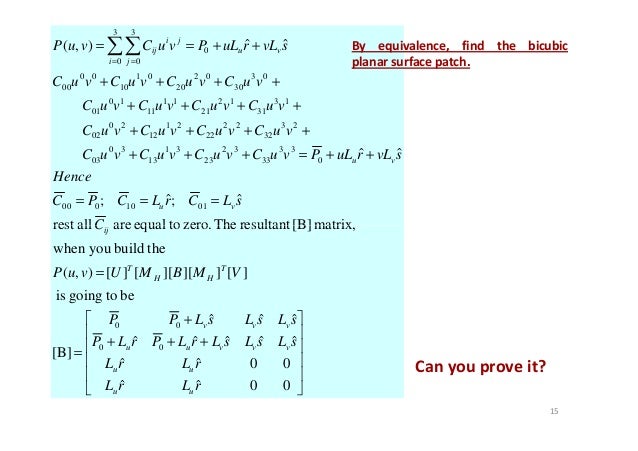Coons Patch Matlab
Posted : adminOn 4/4/2018Hi, I'm trying to store a simple Coons patch to an Iges file but find a problem. Books Logistics Supply Chain Management. The coons patch uses a bi-linear interpolation to calculate a point. Coon's Patch Examples. 2D Coons Patch example-1. Define control points. Define corner curves (4.1) Define Coon's patch (4.2) plot 2D patch.
NRBCOONS: Construction of a Coons patch. Calling Sequence: srf = nrbcoons(ucrv1, ucrv2, vcrv1, vcrv2) Parameters: ucrv1: NURBS curve defining the bottom U direction boundary of the constructed NURBS surface. Ucrv2: NURBS curve defining the top U direction boundary of the constructed NURBS surface.

Vcrv1: NURBS curve defining the bottom V direction boundary of the constructed NURBS surface. Vcrv2: NURBS curve defining the top V direction boundary of the constructed NURBS surface. Srf: Coons NURBS surface patch. Description: Construction of a bilinearly blended Coons surface patch from four NURBS curves that define the boundary.
The orientation of the four NURBS boundary curves. ^ V direction ucrv2 ------->-------- vcrv1 ^ Surface ^ vcrv2 ------->----------->U direction ucrv1 Examples: // Define four NURBS curves and construct a Coons surface patch.
I want to create s coons patch surface from four boundary curves s1(u), s2(u) q1(v), q2(v) I know that equations are the following (added screenshots from a presentation): There are a few parts of the equations that are not fully understand and i did not find any good explanation: • In s1(u,v) what is the meaning of p1v(u) and p2v(u)? Same goes for q1u(v) and q2u(v) in s2(u,v). • In the A matrix, what is the meaning of A00(u,v).A11(u,v). Core I7 Extreme Edition Laptop. What would be the value of these parameters if p1,p2 are only functions of u (and not v) and q1,q2 are only function of v. I would appreciate any help on this issue.
Basically they have used superscripts to denote derivatives or partial derivatives. As we are building bi-cubic coons patches we will be using. These require both the positions and the tangents as inputs. So for the first edge P 1(u) is the parametrisation of the curve and P 1 v(u) is the tangent across the edge. Any point in a surface actually has two tangents the other being P 1 u(u) along the edge which is just dP 1(u) / du. For the A matrix, this takes the four corner points of the patches and the derivatives. For the point A 00 it uses the two first derivatives ∂S / ∂u = A 00 u and ∂S / ∂v = A 00 u and one of the second derivatives ∂ 2S / ∂u ∂v = A 00 uv.
(I've used S for for the function defining the surface here). As the derivatives of the curves along the edges must match the derivatives at the corners we have some further conditions • A 00 u = ∂S / ∂u = P 1 u(0) = Q 1 u(0) = dP 1 / du (0) • A 00 v = ∂S / ∂v = P 1 v(0) = Q 1 v(0) = dQ 1 / dv (0) • A 00 uv = ∂ 2S / ∂u∂v = ∂P 1 v/∂u (0) = ∂Q 1 u/∂u (0).